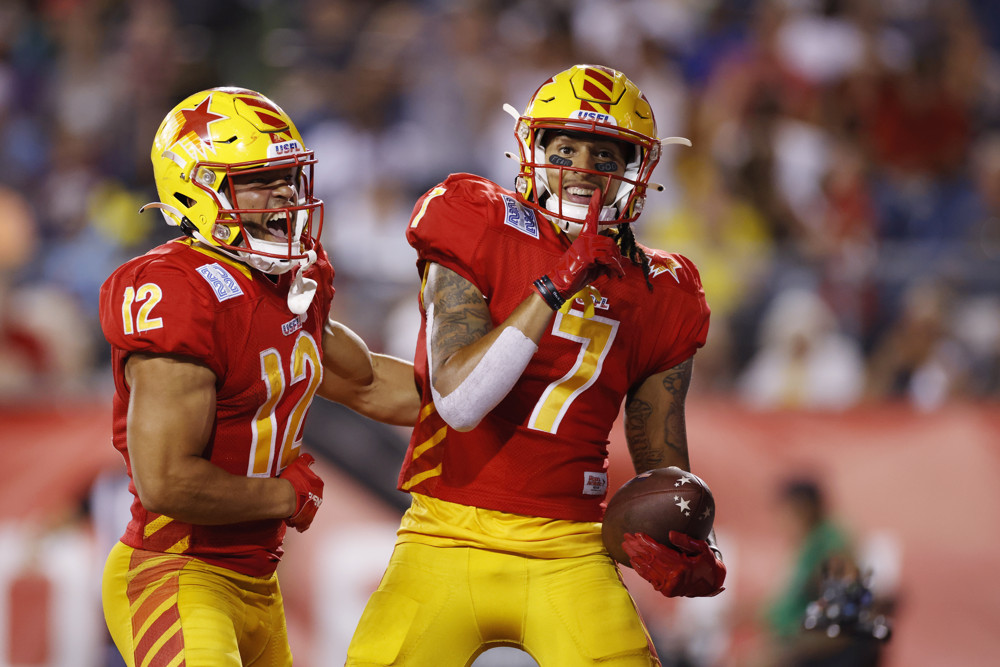Michigan returns defensive-minded HC Mike Nolan for the second straight year but is expected to get an offensive facelift, at least from a fantasy perspective, as OC Eric Marty will be replaced by former Philadelphia Stars OC/WR coach Marcel Bellefeuille. Bellefeuille is certainly an unknown to many professional football fans and likely even to those who consider themselves spring football aficionados, due at least in part to the fact that former Stars HC Bart Andrus got so much credit for their offensive success.
Bellefeuille and Andrus spent time together at a variety of places, dating back to 2012 when Andrus served as the HC of the Omaha Nighthawks while Bellefeuille was the OC/WR coach. They reconnected again in 2021 with the Ottawa Gee-Gees where Bellefeuille was already installed as the team’s HC and Andrus joined as his QB coach. The pair then reconnected most recently in 2022 in the USFL with the Stars, combining to create one of spring football’s pass-happiest offenses. In the five games we tracked last season, Philadelphia posted the league’s highest situation-neutral pass rate (68.0%) on the league’s third-most plays per game (59.2). That tracks with their 2022 play-calling tendencies where they led the league in total pass rate (61.9%) by a wide margin. We should expect Bellefeuille to bring with him the 4-WR sets that were commonplace with the Stars where they utilized 10 personnel on 60.4% of their offensive snaps. Though Philly managed just a 7.8-yard aDOT in 2023, thanks in large part to offensive line woes that resulted in a 10.0% sack rate, their 2022 offense displayed an ability to push the ball downfield with a 10.2-yard aDOT.
Though we expect E.J. Perry to serve as the team’s Opening Day starter, it’s worth noting Danny Etling was added in the offseason and Davis Cheek joined the team as the third-round pick in Phase 2 of the January dispersal draft. As for Perry, he played 20 games in college at the FCS level for Brown University, completing 63.3% of his passes for 6.9 YPA and a 45:27 TD:INT ratio. Perry has made three NFL preseason appearances, completing just 53.3% of his passes for 5.8 YPA and a 1:3 TD:INT ratio. Regardless of who ultimately gets the nod here, it’s one of the weaker QB rooms on paper and their fantasy success will largely be tied directly to the pass-happy nature of Bellefeuille’s offense rather than their own efficiency.
Prior to final roster cutdowns on March 23, Michigan rosters just seven total receivers, making it slightly easier to map out playing time given the anticipation that they’ll utilize plenty of 4-WR sets. Devin Gray will enter his third year in Bellefeuille’s offense after spending the last two in Philly before the team was dissolved in the merger and he was selected in the dispersal draft. Gray has primarily been a slot receiver in this offense — and a productive one at that — earning a 14.6% target share on a 7.4-yard aDOT in 2022 before leading the team in 2023 target share (30.1%) in the games we charted. We can expect him to be a Day 1 contributor as one of the team’s two slot receivers.
Jordan Suell was also with Philadelphia each of the last two seasons and joined Michigan via Phase 2 of the dispersal draft. Suell was less involved in Philly’s offense last season, running a route on 61.1% of dropbacks while earning just a 9.8% target share, but he should be among the perimeter WRs who see consistent playing time.
Trey Quinn remains with the team after finishing second in target share (18.9%) last season. Quinn was a do-it-all receiver in the games we charted, showing he could play inside or outside while running a majority of his routes from the slot (69.4%).
Dezmon Patmon may have been the biggest offseason addition to the WR corps, and the 6-foot-4, 225-pound wideout figures to be involved on the perimeter. This will be Patmon’s first spring football experience after spending the previous four seasons in the NFL with the Colts and most recently the Bills. He was productive in eight NFL preseason games, posting a 23/379/2 receiving line, production that is largely unheard of from his position in limited snaps.
Marcus Sims and Devin Ross were also with the team last season but were minimally involved in the offense. Ross ran a route on just 10.4% of dropbacks and managed only a 3.1% target share and Sims wasn’t much more active, tallying just 10 total targets in seven appearances.
For the first time in three years, Michigan’s backfield will have fresh faces, as both Reggie Corbin and Stevie Scott have moved on and a quartet of capable ball carriers were added in their place. If we’re talking spring football backfields, we have to start with Wes Hills, who joins Michigan via the dispersal draft after dominating touches in New Orleans’ backfield last season, ultimately leading the entire league in rushing yards (680) and adding 38/278/0 as a receiver. The 6-foot-1, 218-pound Hills proved he could be an every-down back last season. Michigan actually used an earlier pick in the dispersal draft on former Philadelphia Stars RB Matt Colburn. In his last two seasons with the Stars, Colburn racked up 179/721/12 on the ground, adding another 33/248/2 as a pass catcher.
Nate McCrary will join the fold as the third RB on the roster after spending the last three seasons in the NFL with Baltimore, Green Bay, and Cleveland. During his time in the NFL, he appeared in nine preseason games, totaling 66/246/2 on the ground. I suspect Hills gets the first crack at a lion’s share of the team’s carries, but Michigan can carry three RBs on their game day roster and may ultimately utilize all three in what we expect to be a pass-heavy offense.


